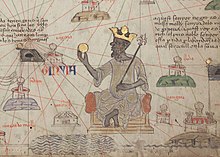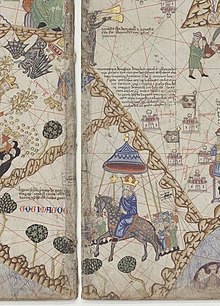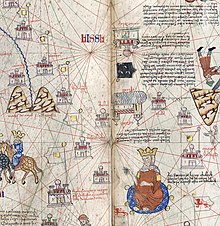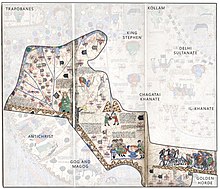Catalan Atlas


The Catalan Atlas (Catalan: Atles català, Eastern Catalan: [ˈatləs kətəˈla]) is a medieval world map, or mappa mundi, probably created in the late 1370s or the early 1380s (often conventionally dated 1375),[1][2] that has been described as the most important map of the Middle Ages in the Catalan language,[3][4] and as "the zenith of medieval map-work".[4]
It was produced by the Majorcan cartographic school, possibly by Cresques Abraham, a Jewish book illuminator who was described by a contemporary as a master of mappae mundi as well as of compasses.[5] It was in the royal library of France by 1380, during the reign of King Charles V, and is still preserved in the Bibliothèque nationale de France. The Catalan Atlas originally consisted of six vellum leaves (each circa 64.5 by 50 cm [25.4 by 19.7 in]) folded vertically, painted in various colours including gold and silver.[6] They were later mounted on the front and back of five wooden panels, with the ends enclosed in a leather binding by Simon Vostre c. 1515, restored most recently in 1991. Wear has split each leaf into two.[6]
Description
The first two leaves contain texts in Catalan covering cosmography, astronomy, and astrology. These texts are accompanied by illustrations. The texts and illustration emphasise the Earth's spherical shape and the state of the known world. They also provide information to sailors on tides and how to tell time at night.[7]
The four remaining leaves make up the actual map, with Jerusalem located close to the centre; two depict the Orient; the remaining two show Europe, along with North and West Africa. The map is around 1.3 m2 (14 sq ft) in size. It shows illustrations of many cities—Christian cities with a cross, other cities with a dome—and with each city's political allegiance indicated by a flag. Wavy blue vertical lines are used to symbolise oceans. Place names of important ports are transcribed in red, while others are indicated in black. The illustrations and most of the text are oriented towards the edges of the map, suggesting it was intended to be used by laying it flat and walking around it.[8]
The oriental portion of the Catalan Atlas illustrates numerous religious references as well as a synthesis of medieval mappae mundi and the travel literature of the time, especially Marco Polo's Book of Marvels and Mandeville's Travels and Voyage of Sir John Mandeville. Many Indian and Chinese cities can be identified.[9] The explanatory texts report customs described by Polo and catalogue local economic resources, real or supposed.[citation needed]
The Western portion is similar to contemporary portolan charts, but contains the first compass rose known to have been used on such a chart.[4]
Mali Empire

The Mali Empire and its riches are shown under the rule of Mansa Musa. The caption reads:
This black Lord is called Musse Melly and is the sovereign of the land of the black people of Gineva. This king is the richest and noblest of all these lands due to the abundance of gold that is extracted from his lands.[10]
Kanem-Bornu Empire

The Catalan Atlas makes allusion to the Kanem-Bornu Empire under the name Ray de Organa.[11] The caption on the map reads “Here rules the King of Organa, a Saracen that constantly battles with the Saracens of the coast and with other Arabs.”[12] The flags with depictions of palm trees correspond to the flag of the Kanem-Bornu Empire.[13]
India

The western part of the Indian subcontinent is clearly depicted, and several of the location names are accurate.[14][15] To the north appears the Sultan of Delhi (Rey de delli), the ruler of the contemporary Delhi Sultanate, with his flag on numerous cities (![]() ). The caption reads:
). The caption reads:
Here is a great sultan, powerful and very rich: the sultan has seven hundred elephants and a hundred thousand horsemen under his command. He also has countless foot soldiers. In this part of the land there is a lot of gold and precious stones.[16]
In the center of India appears the traditional Yadava capital of Diogil ("Deogiri", or Devagiri ![]() ). On top of the city of Diogil floats a peculiar flag (
). On top of the city of Diogil floats a peculiar flag (![]() ), while coastal cities are under the black flag of the Delhi Sultanate (
), while coastal cities are under the black flag of the Delhi Sultanate (![]() ).[17][18] Devagiri was ultimately captured by Alauddin Khalji of the Delhi Sultanate in 1307.[19] The trading ship raises the flag of the Ilkhanate (
).[17][18] Devagiri was ultimately captured by Alauddin Khalji of the Delhi Sultanate in 1307.[19] The trading ship raises the flag of the Ilkhanate (![]() ). Its caption reads:
). Its caption reads:
Let it be known that these ships are named nichi, and measure sixty cubits in depth and thirty-four cubits in length; there are few with less than four masts and some even have ten. The sails are made of reed and palm leafs.[20]
To the south, at the tip of India, appears the "King of Colombo" with a Christian flag (![]() ). He was identified as Christian due to the early Saint Thomas Christianity there (since at least the 8th century), and the Catholic mission there under Jordan Catala since 1329.[21] His caption reads:
). He was identified as Christian due to the early Saint Thomas Christianity there (since at least the 8th century), and the Catholic mission there under Jordan Catala since 1329.[21] His caption reads:
Jordan, Christian missionary to Colombo from 1329, who wrote "Book of Marvels" (Mirabilia descripta, 1340), was probably the source of the information about Colombo in the Catalan Atlas.[21] He mentions the earlier presence of the Saint Thomas Christians in India.[22]
Il-Khanate

The Mongol Il-Khanate ruler and his dominions are depicted in the area of Persia under the title "Rey del tauris", after his capital city of Tabriz. The Ilkhanate flag also appears: ![]() .[23][15]
.[23][15]
The caption is only related to the city of Babylon:
Here there was the Great Babylonia, where Nabuconodosor resided, and that is called Baldaca today. Let it be known that many spices, as well as other noble products, come to this city from the Indies and they are distributed by Siria, in particular at the city of Damascus.[20]

 ), sailing the Indian Ocean towards the coast of India under the control of the Delhi Sultanate (
), sailing the Indian Ocean towards the coast of India under the control of the Delhi Sultanate ( )[24]
)[24]Over him appears a city within a sphere, with the following caption, mentioning the Persian city of Shiraz and Ptolemy:
This city is named Siras, and in antiquity, it was named the City of Grace because it was there where astronomy was invented by the great wise man Ptolemy.[20]
Two ships with flags of the Ilkhanate appears on the India Ocean, sailing to and from the Indian coast, where appear flags of the Delhi Sultanate. The label attached to one of the ships reads:
Know that these ships are called junks (inchi) and have sixty-cubit hulls with thirty-four cubits of freeboard. They have on top of this between four and ten masts, and their sails are of canes and palm.[25]
Golden Horde

The Mongol polity of the Golden Horde is accurately depicted north of the Caspian Sea. The ruler named Jani Beg has been identified in this representation, being mentioned as "Jambech senyor de Sarra", and the flag of the Golden Horde also appears (![]() ).[23] The caption to the right reads:
).[23] The caption to the right reads:


 , dated 1273–1275
, dated 1273–1275Here resides the emperor of this northern region whose empire starts in the province of Bulgaria and ends at the city of Organcio. The sovereign is named Jambech, Lord of the Sarra. [20]
The symbolism of the Golden Horde flag depicted by the Catalan Atlas (![]() ) is fairly similar to the type of tamgha symbols (such as
) is fairly similar to the type of tamgha symbols (such as ![]() ) actually found on the coinage of the Golden Horde.[26][27] Such symbols were used until the time of Jani Beg, but essentially disappear thereafter.[28]
) actually found on the coinage of the Golden Horde.[26][27] Such symbols were used until the time of Jani Beg, but essentially disappear thereafter.[28]
The text to the left reads:
Let it be known that those that wish to cross this desert stop and rest during a week in a city named Lop. Here, expeditions and their animals relax/enjoy themselves. After that, they procure what is needed for the next seven months of the journey, because in the desert one travels an entire day and night before reaching potable water; however, every day and a half, they can find plenty of it, enough for fifty or a hundred people or even more. And if it happens that a rider, tired by the journey, falls sleep or for any other reason he separates from his companions, he will often hear the voices of devils, similar to the voices of his companions, often calling him by his own name. In this way, the devils take him through the desert to a fro such that the traveler cannot find his companions. A thousand stories are known about this desert.[20]
Anatolia

The Anatolian Beyliks, a group of Turkic principalities in Anatolia are also depicted, in the region labelled Turqhia (Turkey). The caption next to the seated ruler in Anatolia reads: Asia Minor also called Turkey, where there are many cities and castles.[29][30] Numerous Turkic principalities appear, with a variety of flags, but very little prominence is given to the Orthodox princes of the Byzantine Empire, although several Byzantine cities appear with the Byzantine imperial flag (![]() ), or Trebizond (
), or Trebizond (![]() ).[30] The Christian kingdom of Cilician Armenia appears heavily fortified within green walls, with its ports and flags (
).[30] The Christian kingdom of Cilician Armenia appears heavily fortified within green walls, with its ports and flags (![]() ,
, ![]() ) clearly visible.[31][32]
) clearly visible.[31][32]
Gog and Magog

The land of "Gog i Magog" (Gog and Magog) appear in the top right corner. Its king is mounted on a horse, followed by a procession. Next to it appears Alexander's Gate, showing Alexander, the Antichrist, and mechanical trumpeters.
Chagatai Khanate

The Khan Kebek, Mongol ruler of the Chagatai Khanate is depicted with the following caption:
Here reigns the King Chabech (Kebek), lord of the Medeja [Media] Empire. He resides at Emalech (Almaliq).[33][34]
His cities appear with the Chagatai flag (![]() ).[35]
).[35]
Cathay (China)

 ) appears on all the territory.
) appears on all the territory.The cities of Cathay, at that time the Empire of the Great Khan (Yuan China), are shown raising a flag with three red crescent moons (![]() ). The flag is seen all over eastern Asian cities in the Catalan Atlas.[38]
). The flag is seen all over eastern Asian cities in the Catalan Atlas.[38]
Kubilai Khan appears enthroned and wearing a green coat, with the following caption:
The most powerful prince of the Tartars is named Holubeim [Kubilay Khan], that means Great Khan. This emperor is richer than any other emperor in the world. This emperor is protected by twelve thousand horsemen with their four captains that stay at the court three months of the year.[34]
Antichrist

The Antichrist appears beyond the Great Wall of China, next to the territory of Gog and Magog. The label reads:
Antichrist. He will be raised in Goraym of Galilea, and at the age of thirty he will start to preach in Jerusalem; contrary to the truth, he will proclaim that he is Christ, the living son of God. It is said that he will rebuild the Temple.[39]
In the top corner is Alexander the Great ("Allexandri") fighting the devil.
Beyond is the ocean ("Mare Oceanis"), without mention of Japan.
Gallery
- Modern copy of western half
- A modern reproduction of the Catalan Atlas depicting the eastern Mediterranean region
- Reproduction of the first leaf
- Reproduction of the second leaf
- Depiction of a Sanhaja Berber, known as the 'veiled ones'
See also
References
- ^ Ferandez-Armesto, F.F.R. (1995). The European opportunity. Aldershot, Great Britain ; Brookfield, Vt. : Variorum. p. 291. ISBN 978-0-86078-501-9.
The Catalan Atlas is conventionally attributed to 1375, because that year is used as the starting-point for the computation of the Golden Number, but 1376 and 1377 are also mentioned in its accompanying texts; it conforms closely to the description of such an atlas in the French royal library catalogue, dated 1380 [...] The Catalan Atlas can be assigned with some confidence to the late 1370s or the early 1380s.
- ^ The date "1375" is mentioned in several places in the map: Gunn, Geoffrey C. (15 October 2018). Overcoming Ptolemy: The Revelation of an Asian World Region. Rowman & Littlefield. p. 67. ISBN 978-1-4985-9014-3.
- ^ Cecil Roth (1940). The Jewish Contribution To Civilization. Harper. pp. 69–72. ISBN 9781443725231. Retrieved 2010-04-28.
- ^ a b c Clayton J. Drees (2001). The Late Medieval Age of Crisis and Renewal, 1300–1500: A Biographical Dictionary (The Great Cultural Eras of the Western World). Greenwood. pp. 119–120. ISBN 0-313-30588-9.
- ^ Harwood, Jeremy (2006). To the Ends of the Earth: 100 Maps that Changed the World. F+W Publications Inc.
- ^ a b "Espagnol 30". Bibliothèque nationale de France (in French). Archived from the original on Feb 8, 2023.
- ^ Edwin Castano. "Catalan World Atlas". 9 Maps That Have Shaped The World. Martian Herald. Archived from the original on 11 July 2019. Retrieved 11 July 2019.
- ^ Botton, Jerry (2014). Great Maps. DK Publishing. p. 62. ISBN 9786027244962. Retrieved 26 July 2018.
- ^ Dhani Irwanto (27 March 2019). Taprobana: Classical Knowledge of an Island in the Opposite-Earth. Indonesia Hydro Media. p. 15. ISBN 9781465435613. Retrieved 11 July 2019.
- ^ "The Cresques Project - Panel III". www.cresquesproject.net.
- ^ Northrup, David (2017). Seven Myths of Africa in World History. Hackett Publishing. pp. ix. ISBN 9781624666414.
- ^ "Panel IV". The Cresques Project.
- ^ "Tchad Heraldry".
- ^ Cartography between Christian Europe and the Arabic-Islamic World, 1100-1500: Divergent Traditions. BRILL. 17 June 2021. p. 176. ISBN 978-90-04-44603-8.
- ^ a b Gunn, Geoffrey C. (15 October 2018). Overcoming Ptolemy: The Revelation of an Asian World Region. Rowman & Littlefield. p. 68. ISBN 978-1-4985-9014-3.
- ^ a b Liščák, Vladimír (2017). "Mapa mondi (Catalan Atlas of 1375), Majorcan cartographic school, and 14th century Asia" (PDF). International Cartographic Association. 1: 5. Bibcode:2018PrICA...1...69L. doi:10.5194/ica-proc-1-69-2018.
- ^ Antiquities from San Thomé and Mylapore. 1936. pp. 264–265.
- ^ Kadoi, Yuka (2010). "On the Timurid flag". Beiträge zur islamischen Kunst und Archäologie. 2: 148. doi:10.29091/9783954909537/009.
...helps identify another curious flag found in northern India – a brown or originally silver flag with a vertical black line – as the flag of the Delhi Sultanate (602-962/1206-1555).
- ^ Beaujard, Philippe (2019). The worlds of the Indian Ocean : a global history : a revised and updated translation. Cambridge University Press. p. Chapter 8. ISBN 978-1-108-42456-1.
The sultan captured the Rajput fort of Chitor, in Rājasthān, and in 1310 he subjected most of the Deccan to his power. He took Devagiri – the capital of the Yādava – in 1307
- ^ a b c d e "The Cresques Project - Panel V". www.cresquesproject.net.
- ^ a b Liščák, Vladimír (2017). "Mapa mondi (Catalan Atlas of 1375), Majorcan cartographic school, and 14th century Asia" (PDF). International Cartographic Association. 1: 4–5. Bibcode:2018PrICA...1...69L. doi:10.5194/ica-proc-1-69-2018.
- ^ Jordanus, Catalani; Yule, Henry; Parr, Charles McKew donor; Parr, Ruth (1863). Mirabilia descripta : the wonders of the East. London : Printed for the Hakluyt Society. p. 23, paragraph 31.
- ^ a b c d Massing, Jean Michel; Albuquerque, Luís de; Brown, Jonathan; González, J. J. Martín (1 January 1991). Circa 1492: Art in the Age of Exploration. Yale University Press. p. 29. ISBN 978-0-300-05167-4.
- ^ Dang, Baohai; Rong, Xinjiang (9 November 2021). Marco Polo and the Silk Road (in Chinese). Beijing Book Co. Inc.
- ^ Sapiats que aquestes naus són appellades Nichi e han ·LX· coldes de carena e hobren ·XXX·IIII· coldes e menys han encara de ·IIII· arbres fins en ·X· e les [lurs] veles són de canes e palma. Buchon, Jean Alexandre (2011). Notice D'un Atlas En Langue Catalane, Manuscrit de L'An 1375 Conservé Parmi Les Manuscrits de La Bibliothèque Royale Sous Le Numéro 6816, Fonds Ancien (PDF). p. 120. ISBN 978-1271741458.
- ^
 Coinage of Mengu-Timur. Bulghar mint. Dated AH 672 or 3 (AD 1273-1275)
Coinage of Mengu-Timur. Bulghar mint. Dated AH 672 or 3 (AD 1273-1275)
- ^ Asiatische Forschungen. O. Harrassowitz. 1982. p. 184. ISBN 978-3-447-02273-6.
The tamga ( a sign of ownership or of belonging to a clan ) drawn on the flag can be seen on coins minted in Bulgar and Bilyar at the time of the early Golden Horde. (...) Besides the Catalan atlas of 1375 there is also a 50 x123 cm Catalan map preserved in Paris.
- ^ FEDOROV-DAVYDOV, GERMAN A. (2003). "The Monetary System of The Golden Horde" (PDF). Paleograph Press: 349.
Tamga in the form of a two-pointed prong was retained on the coins minted in Bolgar, Mokhsha and the Crimea up until the reign of Janibek, marking the disappearance of this image for the rest of the 14th century.
- ^ a b "The Cresques Project - Panel IV". www.cresquesproject.net.
- ^ a b c Forêt, Philippe; Kaplony, Andreas (30 November 2008). The Journey of Maps and Images on the Silk Road. BRILL. p. 194. ISBN 978-90-474-2497-0.
- ^ Massing, Jean Michel (1 January 1991). Circa 1492: Art in the Age of Exploration. Yale University Press. p. 27. ISBN 978-0-300-05167-4.
The Cilician kingdom of Armenia Minor is more clearly indicated. Founded at the end of the twelfth century, it fell to the Turks in 1375
- ^ Galichian, Rouben (2014). Historic Maps of Armenia - The Cartographic Heritage. Abridged and updated. BENNETT & BLOOM. p. 59.
- ^ Açi senyoreya lo rey Chabech, seynior qui es dit del imperi de Medeia. Aquest esta en Emalech. in Buchon, Jean Alexandre (2011). Notice D'un Atlas En Langue Catalane, Manuscrit de L'An 1375 Conservé Parmi Les Manuscrits de La Bibliothèque Royale Sous Le Numéro 6816, Fonds Ancien (PDF). p. 135. ISBN 978-1271741458.
- ^ a b c "The Cresques Project - Panel VI". www.cresquesproject.net.
- ^ Massing, Jean Michel (1 January 1991). Circa 1492: Art in the Age of Exploration. Yale University Press. p. 30. ISBN 978-0-300-05167-4.
- ^ a b Buchon, Jean Alexandre (2011). Notice D'un Atlas En Langue Catalane, Manuscrit de L'An 1375 Conservé Parmi Les Manuscrits de La Bibliothèque Royale Sous Le Numéro 6816, Fonds Ancien (PDF). p. 131. ISBN 978-1271741458.
- ^ Kadoi, Yuka (2010). "On the Timurid flag". Beiträge zur islamischen Kunst und Archäologie. 2: 144, 149. doi:10.29091/9783954909537/009.
- ^ Cavallo, Jo Ann (28 October 2013). The World Beyond Europe in the Romance Epics of Boiardo and Ariosto. University of Toronto Press. p. 32. ISBN 978-1-4426-6667-2.
- ^ "Catalan Atlas. The Cresques Project - Panel VI". www.cresquesproject.net.
Further reading
- Edson, Evelyn (2007). The World Map 1300-1492. Baltimore: Johns Hopkins University Press. pp. 74–86. ISBN 978-0801885891.
External links
- "Mapamundi: Edizione digitale a cura di Giulio Avincola, Paolo Canettieri, Emanuele Di Meo, Max Mercader, Elisa Verzilli".
- Bibliothèque nationale de France – L'Atlas Catalan (in French)
- Complete transcription of the Catalan language text, and translation to French (1839): Buchon, Jean Alexandre (2011). Notice D'un Atlas En Langue Catalane, Manuscrit de L'An 1375 Conservé Parmi Les Manuscrits de La Bibliothèque Royale Sous Le Numéro 6816, Fonds Ancien (PDF). p. 135. ISBN 978-1271741458.
- The Catalan Atlas (in English) [via Internet Archive]
- cresquesproject.net – translation of the works of Riera i Sans and Gabriel Llompart on the Jewish Majorcan Map-makers of the Late Middle Ages (in English)
- Abraham Cresques ? Atlas de cartes marines, dit [Atlas catalan], gallica.bnf.fr








